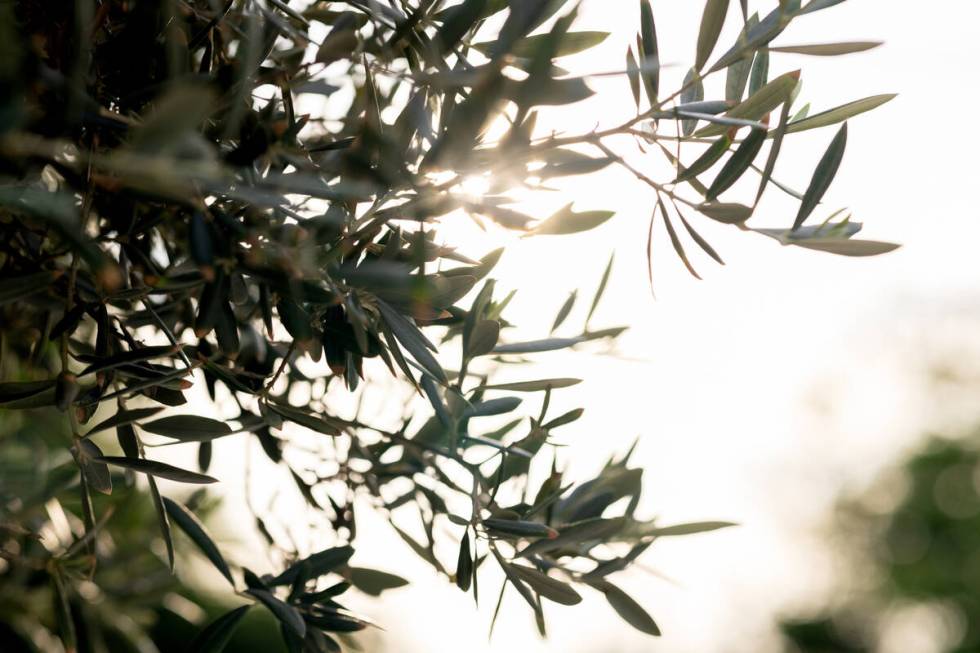Why fruitless olive is not a good option for replacement tree

Q: A tree in my front yard was damaged by the wind a couple of weeks ago, and I need to have a new tree planted. My house faces south, with lots of wind and sun, and is one story in front but two in back. There is artificial turf on one side of the location where the tree will go and a paver walkway on the other. The house is probably about 6 feet from the tree, and root barrier was installed along the paver pathway. I’m considering a fruitless olive. Is this an appropriate selection? If not, what do you suggest?
A: European olive is not a good choice for a tree replacement if you have only 6 feet available. An olive tree has a shape, in maturity, that is round and quite a bit taller than that space (30 feet tall by 30 feet wide). A better choice is a tree smaller in size (perhaps 15 feet tall by 6 feet wide at maturity) and more upright — if a tree is to go there at all. Make sure if a tree is planted there — to eliminate major limb removal later on — that it is turned so that its main branches don’t interfere with the house.
Dig the hole no deeper than the root ball but two to three times wider. When planting it, make sure the soil is amended with about 15 to 20 percent compost to get it, and any neighboring plants, off to a good start. When backfilling the soil around the root ball, the amended soil should be muddy to get rid of any air pockets.
Stake the plant, at least in its first year, to aid in the establishment of its roots against any wind. Drive the stakes into solid soil beneath it after it is planted. Remove the stakes after one season of growth.
Q: I have a Barbara Karst bougainvillea. Something is eating the bracts in little semicircles, and I never see anything actively on the bracts. Please point me in the right direction as to what could be causing this and how to prevent it.
A: The neatly cut circles in leaves and flowers is leaf-cutter bee damage. This bee doesn’t live in hives and is not a social insect. It is slightly smaller than the Italian honeybee that we are most familiar with, but it does a lot of summertime pollination for our gardens. It is a good guy.
The problem with this bee is that the female cuts circles out of tender leaves and flowers of many different plants. This insect chooses softer, succulent leaves and floral parts over those that are thicker and harder to cut. People who love roses know this insect well. She takes these leaf cuttings and uses them to pack the holes and crevices when laying her eggs.
You should not be using any insecticides to control bees. Just live with this damage and grow more plant material to lessen the amount of visual damage to your plants. When I see this damage in the orchard, usually in the grapes or in tender leaf herbs like basil, I think of it as “good damage” because I know this insect is doing more good than bad.
Q: I saw the question from reader on single dead Texas sage limb. My son had similar symptoms on a sage plant and discovered termites inside the limb. He treated the sage with termiticide applied into holes he drilled in the limb. I was surprised that shrubs could have termites.
A: Your situation may beg the question: Were these “termites” found in Texas rangers that were already dead or did they cause the stem of this plant to die?
The course of action might be different depending on the answer. If the plant was dead at the start, then pruning out the dead part of the stem might be the simplest answer. If it was alive when it started, then a labeled, systemic insecticide to prevent it from spreading might be the answer.
Termites (same order as cockroaches) are difficult to tell from ants (same order as wasps and honeybees). These insects look like they might have similar scientific names, but they don’t.
Visually, the easiest way to tell the difference between termites and ants are the antennae attached at the head (termite antennae are straight, while the ants’ antennae have distinct elbows).
It has been said that the difference between mature termites and ants is in the waist: An ant’s waist is more wasplike, while the termite is straight.
Both termites and ants can be found tunneling into seemingly healthy, dying or dead plants — but for different reasons.
When it comes to insecticide versus termiticide, choose the right one and the right reason for using it.
Bob Morris is a horticulture expert and professor emeritus of UNLV. Visit his blog at xtremehorticulture.blogspot.com. Send questions to Extremehort@aol.com.